
An article published in the journal “Nature Astronomy” reports an analysis of the isotopic composition of six groups of iron meteorites, and the results offer evidence that some of the materials that formed the planet Earth came from red giant stars. Mattias Ek of the University of Bristol, Alison C. Hunt, Maria Lugaro and Maria Schönbächler examined in particular the isotopic composition of palladium finding that some dust has a composition that can be produced only by nuclear reactions that take place in red giants’ inner regions. This offers an explanation of the greater presence of that type of dust on Earth than on Mars or in asteroids.
Advances in measurement techniques obtained in recent years allowed to analyze the chemical composition of stardust to better understand the formation of planets and minor bodies from the protoplanetary disk existing at the dawn of the solar system’s history. The proportions of the various elements’ isotope are like fingerprints that show that stardust spread unevenly.
In the last decade various studies have been carried out focused on specific elements verifying their uneven distribution on Earth and in meteorites fallen on the Earth such as the Muonionalusta in the photo (©Windell Oskay). However, the distribution of palladium was less uneven, a surprise considering that the various heavy elements must have been produced by ancient stars that died billions of years ago and pushed towards what became the solar system.
Mattias Ek conducted measurements of palladium during his doctoral research at ETH Zurich, Switzerland. Now, together with other researchers he proposes a new model to explain those results based on the theory that stardust consists mainly of materials produced in red giants. Those stars near the end of their lives reach in the inner areas hundreds of millions of degrees of temperature with the production of heavy elements that subsequently get ejected into interstellar space.
Maria Lugaro of the Konkoly Observatory in Budapest, Hungary, and the Monash Center for Astrophysics in Clayton, Australia, explained that she and her colleagues found out that the ratio between the palladium isotope 108 and 106 is different on Earth compared to the analyzed iron meteorites. This indicates that the Earth contains more stardust. Maria Schönbächler of ETH Zurich added that the reason for this difference is due to the evaporation of unstable dust grains during the formation of planets closer to the Sun, where temperatures were higher. The grains from red giants were more stable therefore on the Earth there are still larger amounts than on Mars and asteroids farther from the Sun.
When a scientist states that we’re children of the stars that’s precisely because the heavy elements that also form our bodies were generated by nuclear reactions within very ancient stars. Research like this helps to understand which elements were generated in supernovae and which ones in red giants and the processes that led to the solar system formation. This also provides information on the processes that allowed the birth and development of life on Earth, useful to try to understand where we could look for other life forms.

